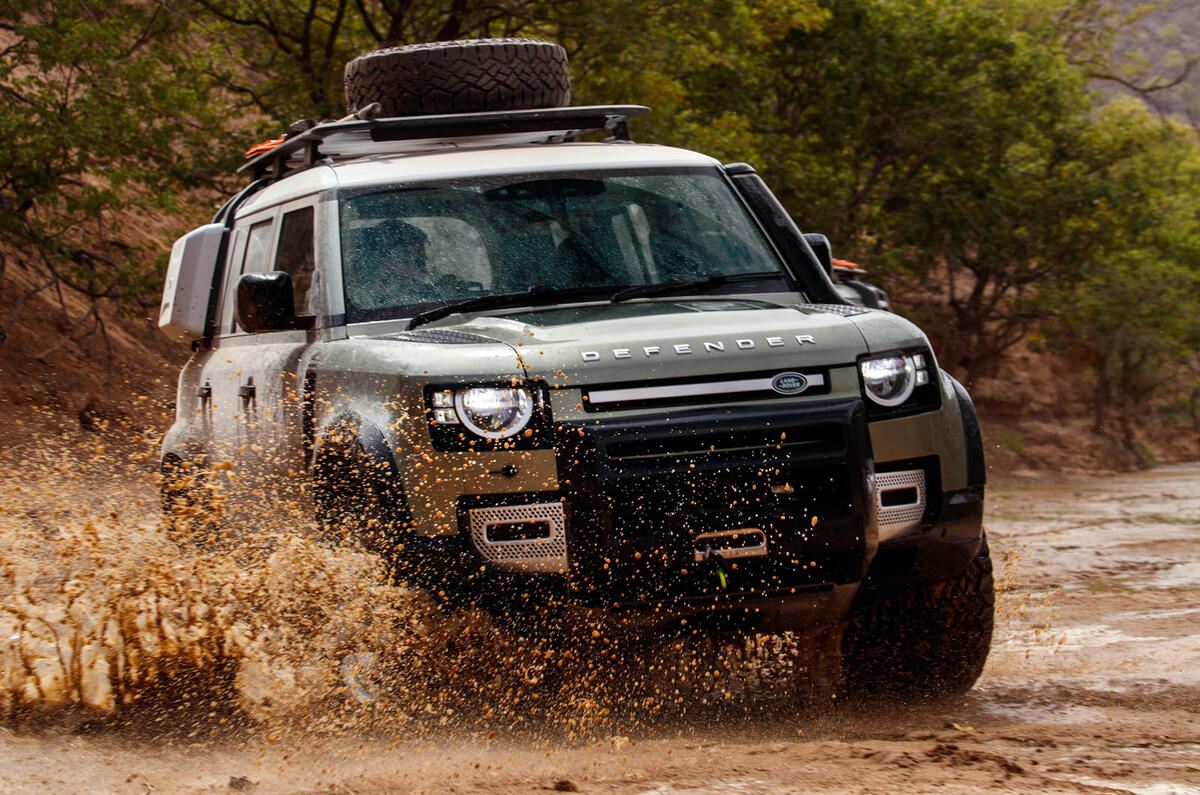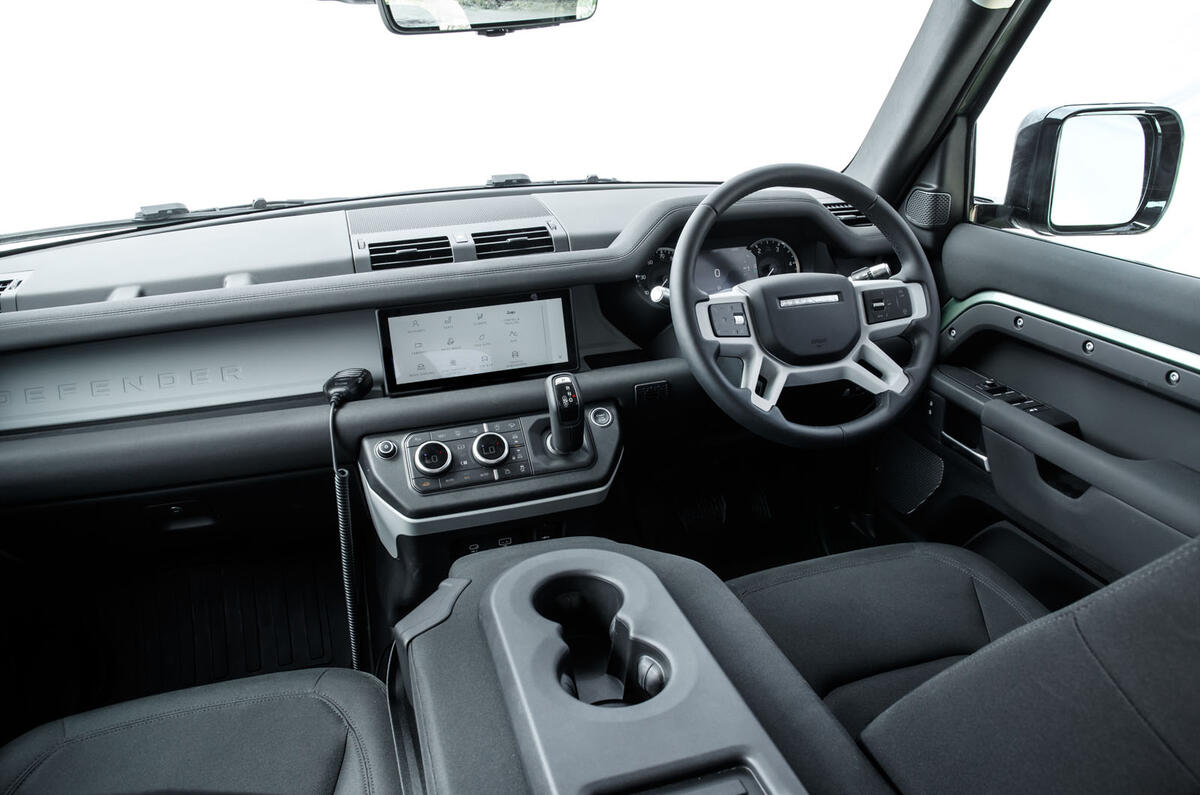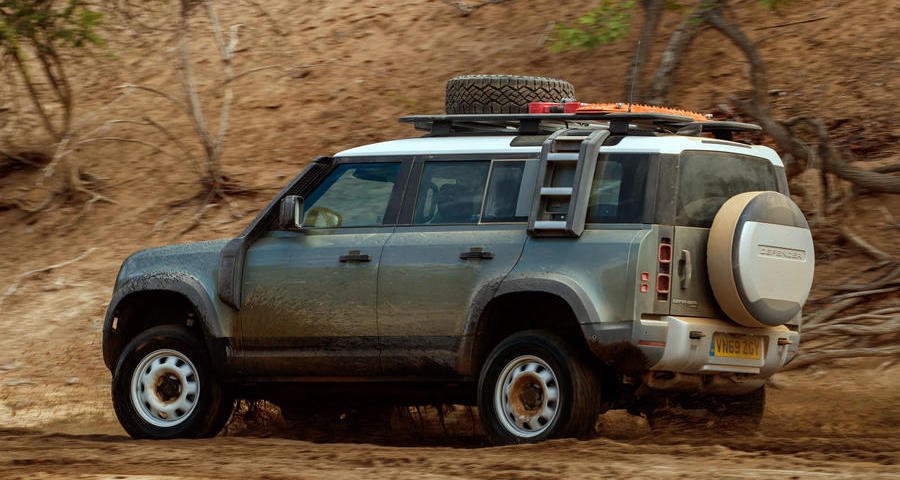What is it?
I don't know if it's bold or reckless to launch a Land Rover in Namibia.
Not because of the barrenness, what with it being the second least densely populated country on earth, having a land mass three and a half times the UK's but only 2.5 million inhabitants. Not because the terrain is challenging and so vast that there's a national park the size of Belgium.
No, it's because the default car of choice is a Toyota.
It's not that you don't see Land Rovers. Walk around the capital, Windhoek, and you'll find Range Rovers as you will everywhere money lives, but out in the wilds – and Namibia is second only to Mongolia when it comes to wilds – the Hilux is king. Namibia is a country where four in 10 brand-new cars are Toyotas, where it used to be a much higher percentage than that, and where the Hilux's capability and longevity mean that, in the places you'd really want to test a Defender, the cars that aren't Hiluxes are other beaten-up Japanese pick-ups. There are a few old series Land Rovers going on adventures, but the working or adventuring truck market is one, you have to conclude, the Defender left some time ago.
What does it want to be now? Well, this is it, the new Defender, the most difficult vehicle to replace since Volkswagen tried to reinvent the Beetle. The old car had a separate chassis because that's how you did things in 1948 and, although updated during its life, true modernisation had probably faltered by the 1980s and the Land Rover hasn't been a ubiquitous, everyman's vehicle for most of this century.
And so, as with the modern Mini, the new Beetle and the Fiat 500, the reinvention comes. Not an easy task. "All of our marketing blah-blah about reinventing an icon is true, I think," says Felix Bräutigam, Jaguar Land Rover's chief commercial officer, who has joined us for the drive and, having worked at Porsche (and with a 911 GT3 RS 4.0 and the last-ever manual Jaguar F-Type in his garage), I think you'd like him a lot.
"The 60-second elevator pitch for the Defender is 'capability'," he says. "This is not a sport utility vehicle. It's a 4x4."
Interesting distinction, and not one I often make. What else is a 4x4, not an SUV? Search Jeep Wrangler, Mercedes G-Class and Toyota Land Cruiser and you'll find their makers all file them under 'SUV', but Bräutigam has stripped out the term in Defender literature. Land Rover would like you to think this is the real deal, a Land Rover like no other. "Land Rover is a three-legged stool again," he says.
Is it like the old one? If you imagine Land Rover development had continued in, say, Porsche 911 or Honda Civic style, with regular updates and model cycles and some technology step during each one, is this where you'd end up?
I don't think so: the new Defender, one of the most capable vehicles on earth though it may be, is pitched where the previous Defender left off, as a premium want-vehicle, not as the need-vehicle that is how the original series Land Rover began its life.
A 911 has always been a sports car, the Civic always a family runabout. But I think the Defender has changed. That's not necessarily a bad thing. It's just a thing. We can discuss its looks – I will as we go on – but the trouble with assessing design is not that you and I think differently, but that as familiarity sets in, even our respective views change. I already feel differently from how I did when I saw this car last year, for better and worse.
The hardware, then, is where objectivity lies. Underneath the body, with its bluff back end, reassuringly familiar side-opening tailgate and three- and five-door variants badged 90 and 110, sits a derivative of Jaguar Land Rover's big aluminium D7 architecture.
Don't think that means it's overtly based on something else: the platform has a suffix for different models, so a Jaguar XE is a D7a and a Range Rover is a D7u and even a Jaguar I-Pace is D7e. But it means there are shared modules and crash structures and, notably, commonality in the expensive bit between the front axle and the dashboard.
But the new Defender's aluminium shell, in all of the body-in-white and not just the outer panels, is unique to this car. It sits higher than on any other Land Rover, too.
Attached to the bonded and riveted shell are steel subframes front and rear, with independent suspension all round – wishbones at the front, integral link at the back. No, it doesn't have a separate steel chassis any more and nor is there a solid axle to be seen, as you'll still find front and rear on a Wrangler and beneath the back of a Land Cruiser, G-Class and every pick-up. But Land Rover claims a 29kNm/ deg torsional stiffness, a 900kg maximum payload and a towing limit of 3500kg (3700kg in the US).
Engine options are 2.0-litre diesels with 197bhp or 237bhp, a 2.0 petrol with 296bhp and a 3.0 V6 with 396bhp. A plug-in hybrid is coming soon: "We didn't want to make a last hurrah of a pre-Greta era," says Bräutigam. "This is a justifiable car." For now, though, we're driving the most powerful diesel and petrol.
All engines drive through a ZF eight-speed automatic gearbox. There's no manual option and I doubt there will be. There's an electronically controlled centre and rear differential and the Defender gets Land Rover's Terrain Response system, so it is not a car with which you can choose to lock the differentials as you can in a Wrangler or G-Glass. But it does have a low-ratio transfer case and, remember, despite each wheel's independence and the unitary body, it's not an SUV. Well, we'll see.
Later, base models will have coil springs as standard, but early cars – we've driven two 110 variants, with 90s coming later – will run on air springs, one of a raft of technologies that serves to improve the Defender's off-road capability. We'll test that a lot here. "Once through these traffic lights," I'm told at the start of the drive, "we won't see Tarmac again for three days."
What's it like?
I've done enough off-roading to know that this can be quite tiresome, that after three straight days of driving off road, a stretch of smooth asphalt is like a hit of warm sun at the end of winter.
The Defender sets a good first impression on cushioning the blow. There are traditional Defender cues – a big slab of dashboard with a grab handle at either end, with the instruments in their own little binnacle. The steering wheel is huge, driving position high, seats large (that's new) and visibility good (that's not new). You can see where the car ends, where its sides are, and the door mirrors are big, too. As well they might be: while the old Defender was as narrow as a Ford Fiesta and as long as a Ford Focus, this new model is 2105mm wide across its mirrors and 5018mm long, including the spare wheel – a luxury car footprint with Land Rover's longest wheelbase, at 3022mm. The 90 is half a metre shorter in both wheelbase and length.
Interior materials feel good, albeit this is a higher-spec car. There are some exposed structural elements and Torx-head bolts to enhance the adventurous feel; although that's better achieved by the amount of storage space and charge outlets the Defender brings you, which, as you'll know if a lot of you are travelling for a long time, is what really matters. And there's a new infotainment system. Touchscreen, yes, but it's good. No, I mean it. For the first time in a Land Rover, it's genuinely quick, clear and confident.
You can have two or two-and-a-bit seats in the front, with a middle jump seat you'd use to get a lift home from the pub but for no longer than that. There are three seats in the rear with massive head and leg room – the top window is a nice touch but no more than a distant porthole – and you can spec two seats in the spacious boot (although not with the jump seat). The boot, at 916 litres to 2233 litres with the second row folded, is cavernous, and although you'd probably get a wider access hatch if the tailgate lifted, rather than swung sideways, remember it's a Defender.
The control weights are not traditional Defender. They're light, positive, progressive and, as we mooch out into the countryside, it feels easy and laid back. I think that's important in a car that claims to be so capable; a Land Cruiser manages it in similar fashion. If you're going to spend a long time in one of these, in abnormal road conditions, you'll want a car that's ergonomically easy to rub along with. You can make a case on a car's various ultimate off-road credentials (and see the hard numbers, above left) but reducing fatigue counts.
The ride feels easy, too, on big empty roads where it lopes along with plenty of breath in its lungs. The steering doesn't tell you much or self-centre greatly but it's accurate and stability is good.
A few caveats: we're largely on rough roads – a brief stretch on asphalt suggests the Defender is an engaging road drive too. The steering gains weight and response as forces build, the ride's composed, pliant, but with tight body control and well-contained roll. And we're on knobbly tyres rather than more road-biased ones. Also, there's a roof rack and ladder and a bunch of kit on top of the car, which probably doesn't help dynamics, so I'm impressed that the Defender feels so sure-footed.
The reason for the tyres and the kit, of course, is the terrain. Namibia has all of it. In places, it's rocky, with oodles of small loose stones or big solid ones, but all able to snag a tyre sidewall. And at times, it's sandy, dune-like or more solid or in a riverbed, which when we drive through is flooded with sufficient water to make for a tough wading test, with thick mud beneath. Bar slippery grass, which will be the standard UK test, Namibia has got everything. What I do like about the Defender's design is how it interacts with its surroundings. The drag coefficient is a reasonable Cd 0.38 but there's still been the chance to leave little shelves around the lights that attract and trap dirt and dust; an old Defender does the same and it's something that would be annoying on a BMW 3 Series but works nicely here.
How well the Defender's appearance will otherwise mature I don't know, but following one today, it's novel and largely avoids caricature. In essence, Land Rover admits it gives Discovery 4 owners a car to move on to, but in design terms, there are also shades of first-generation Freelander about its stance when you see it moving.
The Defender is equal to whatever terrain we put its way. It's hard to say how much better or worse than the key rivals it is (even when we do conduct back-to-back testing in the UK, we'll find muddy ground can change as we drive over it, making exact replication hard). But the raw numbers are strong, particularly with the suspension on its highest setting. And with the gearbox in low ratio, both the diesel but more so the petrol have decent urge. The diesel can get a little bogged as you try to keep momentum along soft riverbeds (it is a 2248kg car) and, with no separate chassis, there are no slide rails at the back, but the rear overhang is short, the floor flat, and the front bumper and skid plate the lowest part of the car – so if you clear objects with those, it should clear all the way along.
What's striking, though, and unusual, is how easy the Defender tries to make all of this crawling and wading. In a Wrangler, it feels like off-roading is how you challenge yourself, as you choose to lock the differentials and disconnect the anti-roll bars via cabin switches. Wranglers are incredibly capable, and I love them for it, partly because they make off-roading feel like a hobby.
The Defender tries not to make it a chore. As standard on the models you can spec at the moment is the Terrain Response system that manipulates suspension, differentials, brakes, traction control and more on the go. It also has 360deg cameras, including a through-bonnet one showing the front wheels, and even a wade sensor that tells you when you're approaching its 900mm depth limit – in case water approaching the windows doesn't let you know.
That means you have to get out of the car less, fiddle with buttons less, poke a stick into a stream less, and stay comfortable and at the right temperature more. Tick a couple of boxes and fit the right towbar and it'll even tell you how much weight is on the towball and run a trailer tail-light check without you having to leave your seat.
Should I buy one?
And, yes, are there ever boxes to tick. Prices for five-door Defenders start at £45,000 but, in the specification you see here, the 2.0-litre diesel comes in at around £65,000 and this P400 petrol more like £87,000. Bräutigam admits that early-ordered cars are a "rich mix". Although a commercial Defender will start from around £35,000, it's also possible to spend £100,000 on a heavily optioned five-door.
Which leaves the car where, exactly? Doing some things and costing similar to other Land Rovers, perhaps? It's an argument I've considered before but a BMW X1 overlaps an X2, which does an X3 and so on through 4, 5, 6, 7 and 8, so does this matter? Over three days of musing, I never quite square myself with the price, either, once optioned, but the car's certainly no less impressive – and no more fatiguing – even after hundreds of tough miles.
I keep wondering which car I'd rather be in as terrain changes underfoot. Sometimes a Wrangler (three-door, with a Mopar lift kit, for rock crawling), sometimes a Ford Ranger Raptor (fast on sand), and if I lived in Namibia, I suspect I'd have a Toyota. But whatever the terrain, the Defender would never be out of my top two or three choices, and proper road, where it's extremely amenable, returns as just another surface, not as a relief. Admittedly, there's a price, but be in no doubt: this is one of the most capable vehicles in the world.
Land Rover Defender 110 S specification
Where Namibia, Africa Price £49,880 (base, £66,000 as tested) On sale May Engine 4 cyls, 1999cc, turbocharged, diesel Power 237bhp at 4000rpm Torque 317lb ft at 1400rpm Gearbox 8-spd automatic Kerb weight 2248kg Top speed 117mph 0-62mph 9.1sec Fuel economy 31.7mpg CO2, tax band 234g/km, 37% Rivals Jeep Wrangler Rubicon, Toyota Land Cruiser


Nouvelles connexes



